With over 4 million DNA tests [as of 11 aug 2018 – 10 million], the Ancestry database has reached a tipping point where any tester with American ancestry will get some good cousin matches. How do these help prove an ancestral line? Well when your DNA matches multiple people descended from the same ancestral line, you can have some confidence in that part of your tree. Conversely, if you have no matches on a line, there may be a problem.
On your DNA home page, the center panel summarizes your match count. It shows the number of predicted 4th cousins or closer as well as the number of starred and green leaf ancestors. You can add stars to matches for whatever reason you wish. Only you and anyone you share your DNA results with can see them. Ancestry will indicate each DNA match that also has a tree match with you by using a green leaf.
Notice the big difference in the number of cousins between those with 19th and 20th century immigrant ancestors like my family and those with deep American ancestry. Also foreigners like my Norwegian cousin will have very few, while Jewish testers will have incredibly high numbers due to endogamy.
DNA Matches Page
Click on the green View All DNA Matches button to get to your DNA matches page. Or click on the starred or green leaf matches to see just those matches. On your match list page, every DNA match who also has a matching ancestor to you in their tree is marked with a green leaf indicating a hint.
When there is a green leaf, clicking on the View Match button will take you to a page that will show you a picture of the expected relationship pathway (images of that on page 2 of this article).
Many times matches with no tree will actually have a tree that is just not connected to their DNA. You can see that on the view match page. There you can select it in the dropdown menu, as shown below, to get the usual sideways display with a surname list. Sometimes you can even figure out where they fit in from it.
I like to make Ancestry do the work of checking my assumptions by adding the tentative line to the tree connected to the DNA test. I put a “??” as the suffix when I am trying out a set of ancestors so that anyone copying my tree is warned that it is a test. Strange characters in the suffix box do not seem to affect the matching. Another perhaps better solution is to make your tree private while you experiment. Or to use a second small private tree that you connect your results to when trying out a possible ancestral line. You can change what tree and who your DNA is connected to on the DNA settings page. Get there from the button with a gear on the top right of your DNA home page.
Here are some examples of my experiments.
The Sinking Valley Pennsylvania Beyer family
I had thought my Beyer cousin was descended from the Beiers in the 1736 fifth wave of Schwenkfelder immmigrants (a German religious group that came to Pennsylvania). However she had no DNA matches at all on that line when I connected her ancestor David Beyer b 1763 to the parents listed for him in many trees, Andreas Beyer, born ca 1733 Germany and Philipina Weyand. By comparison, my cousin has dozens of DNA hints to people descended from David’s wife Sara Crum’s parents and their ancestors. Of course there is always the possibility that someone else fathered her ancestor David Beyer or that my cousin just inherited none of his DNA. After all he is a 4th great-grandfather which is pretty far back. However since the paper trail to Andreas was not convincing, I disconnected David from him on all my trees and added another possible set of parents. Still no DNA hint matches there though. It might help if I had more ancestors on that new potential line.
On the other hand when I connected her ancestor Robert Bleakney to a possible set of parents, James Bleakney and Mary Nolph, the matches came pouring in from both sides. There is no real paper trail for this relationship and James would have been 8 when he fathered Robert so I suspect one or both of their birth dates are wrong, probably Robert’s, since the DNA is very convincing. More research is needed.
The Merrills and VanAlstines
My third cousin Dave has one deep American line going back from his great grandad George Merrill. There are several men of that name in about the right time and place so I wondered if I could use Ancestry’s DNA hints to solve this puzzle. I had done my usual deal with Dave, I told him if he DNA tested, I would fill in his family tree for him. This is the only way I can afford to have so many cousins testing!
I had initially built a tentative tree for him using George E. Merrill who I had thought was his ancestor, but this got no DNA hints at all. Now I felt awful since I had told Dave he was descended from a Revolutionary War soldier on that George’s tree. So I looked again and this time tried a tree using George S. Merrill. It helps to have other people to copy from who have these folk in their trees with ancestors, although I always try and double check the sourcing.
A few days later when I got back to looking Dave’s results he had gone from a mere 5 DNA hints (we Norwegians do not have that many relatives at ancestry) to 14 hints. Somewhat amazed, I started looking through these Merrill descended matches and continued his tree back in time. Definitely this is the right George since he shares so many hints from different ancestors on this line all the way back to his 7th grandparents.
This also explains his Van Alstine New Ancestor Discovery (NAD) since George S Merrill’s great grandad married Maria VanAlstine, the sibling of that NAD. These NADs, if you have any, show beneath the 3 panels on the DNA home page. Plus Dave now has several revolutionary soldier ancestors. All is well.
Unexpected Results
Another byproduct of Ancestry‘s powerful DNA matching, is that some people have discovered that their father or grandfather or great-grandfather is not the expected person by seeing that there were no DNA matches on that branch of the tree. Since it is always possible that no one else from that line has tested (likely with immigrants from less tested countries), it is always best to test another relative or two, who should be a match on that line, before reaching any conclusions.
Recently, a young woman was helping an adoptee who was clearly her first cousin in the DNA on her paternal side (her mother is tested). She found the adoptee’s birth mother, not a match to her. So she assumed that their dads should be brothers, but her dad had no brother. Puzzled she consulted me. I pointed out to her that she did not have a single DNA match on her Dad’s side of her tree so either he was adopted, switched at birth or not her dad. Soon thereafter she discovered that her paternal aunt had tested and did not match her at all. Thankfully her discussion about this with her mother went well and the two birth dads are now known.
Blue Leaf Hints Anyone?
Another problem I have noticed occasionally among people I work with is the tendency to confuse tree hints with DNA hints. After all they both use green leaves. But DNA hints are only on the DNA matches page not on the trees. So I encourage all of you to suggest the leaf color should be different for DNA hints. Here is the link to Ancestry‘s suggestion box: https://www.ancestry.com/cs/suggestions
Using Ancestry‘s powerful DNA to tree matching is a clever way to prove or disprove a family branch but be prepared for surprises.
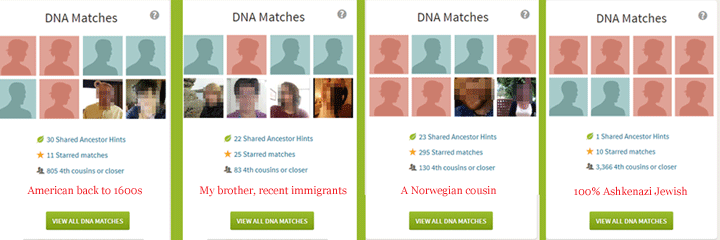
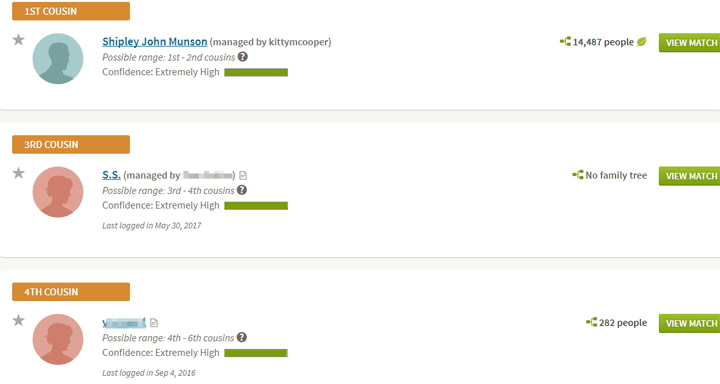

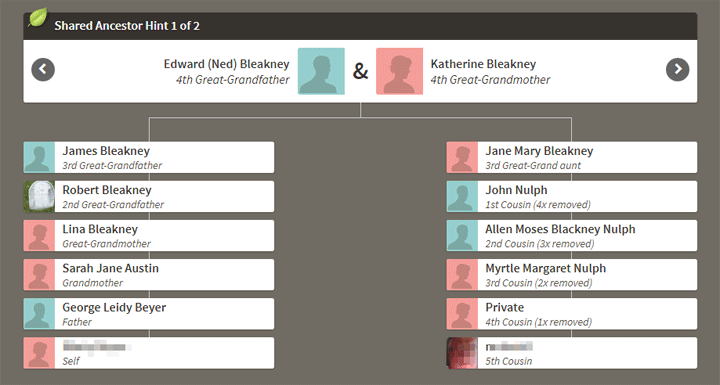
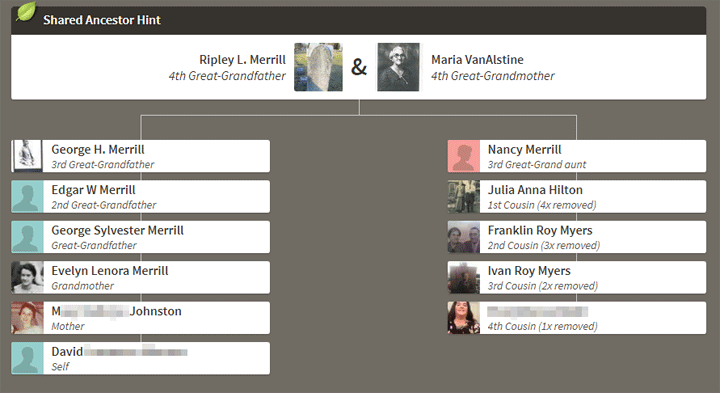

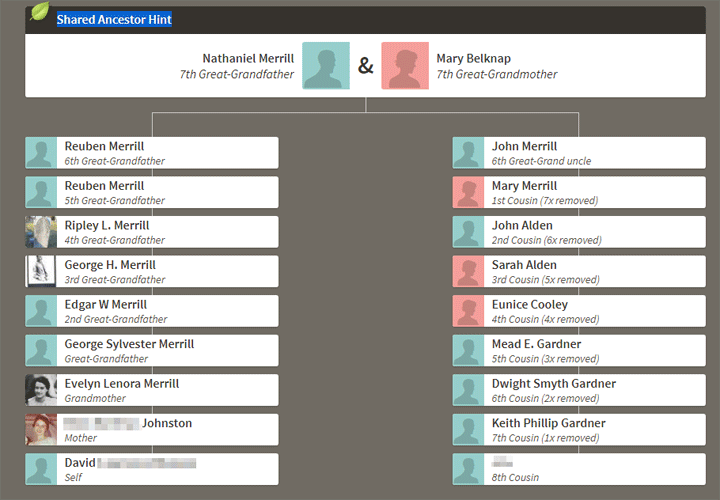
I’m wondering if sometimes when a speculative tree generates many hints, if everyone has the wrong ancestral couple. In other words, yes, they are all related, but the assumed identity of a MRCA that has no paper trail, is wrong.
Peggy, of course that is a concern but in both these cases the many DNA matches shared many different ancestors along the new line. That gives me more confidence than if they all descended from one specific couple.
Also it is always wise to check the sourcing very carefully
One caution. Many of the hints will not be backed with shared DNA. In ancestry, I have my mother’s kit as well as mine. When I sometimes get maternal ancestor hints for my own kit but the match does not appear in my mom’s match list, i know that hint has no genetic proof. (I usually invite the match into GEDMATCH to learn more because the link has to be paternal.)
Hi Kitty,
Nice post! Regarding what you state here:
“Many times matches with no tree will actually have a tree that is just not connected to their DNA. You can see that in the view match page as well. Sometimes you can figure out where they fit in from that tree.”
I’ve yet to notice that or how to do that. Can you show an example of someone who has a tree but has not linked it?
Good to hear from you Ken
I will add an image demonstrating that later …
Ok Ken I added an image in the article for you of how it looks when there is a tree on their match page that is not connected to the DNA and slightly updated the text.
It’s simple. When you are looking at one of your matches and it says “no family tree”……..you with me so far? Well for some of them if you actually click on their name or username or screen name, then look towards the bottom of the screen in the big box it will have a little dropdown box that says select a tree to preview.
Great post! I just added my 4th great grandpa — at least I think that Patrick Caine is father to my John Caine. I also added 2 of Patrick’s presumed children and I will see what I get!
I’ve put my actual researching on hold the last couple of weeks so I could delve into and learn Genome Mate Pro but saw your post so just had to try it. At least my brain isn’t completely dead from all the DNA learning curve!
thanks again!
Thanks Kare!
Best to add Patrick’s parents and grandparents as well as this may get DNA match hints to his ancestors.
Thanks for great tips on getting more out of Ancestry DNA.
By the way, when viewing people’s trees there, I highly recommend the horizontal view–the extra step of clicking the little icon that makes the tree grow left to right instead of bottom up allows easily viewing their ancestors without the clutter of all their ancestors’ siblings and other relatives.
I think the horizontal view should be the default view! JMO!
Amen, regarding Pedigree View! Horizontal rules! Vertical trees? Not so much, especially for members with more than 1000 ancestors in their trees. C’mon, Ancestry…
Great information, Kitty. Does it make any difference which person and at what generation I attach my DNA to in the test tree? For example, could I attach my DNA to a person at my great grandmother’s generation and would this then allow me to extend my line beyond the 4th cousin limit Ancestry imposes? Could I attach both my sisters and my kit to the same test tree? Lastly, since we’re talking atDNA, does it matter whether I connect my/my sisters kit to a male or female in the test tree? Thanks.
Kathi,
Try all these things and let me know! No difference what generation but not sure about the rest.
The other answer I can give to all your questions is that each person has their own account so as far as I know, they each need their own tree
I believe people can transfer his/her management rights to another. Once the transfer has occurred, the new manager should be able to add the DNA test to a tree already connected to other DNA tests.
I have a tree with 14 tests attached to it. Not all of the tests are related to me. A couple of my dad’s first cousins’ spouses have wanted to test. I’ve added the first cousins’ spouses to the tree and attached their DNA to their names on my tree. Everything is working beautifully!
Good timing …. my life is mirror tree’s these days! I wish more Norwegians would test! I feel like I am going nowhere with Kathy’s search 🙁 I’ve got a forrest of mirror tree’s for her and one lowly shared ancestor hint … nothing closer than a 4th cousins. Then a kit I gave to an adoptee was processed this week and boom … almost 1300 4th cousins and closer with 9 2nd cousins and 39 3rd cousins!!!! I couldn’t believe my eyes!!!! Acadians from NFLD! Three day’s of this and I have almost got it figured out! Wow what a difference a day makes!
Shelley when there are only 4th cousin matches i use the GWorks technique explained here http://blog.kittycooper.com/2017/06/my-adoption-workshop-and-a-success-with-gworks/
Let the computer do the work
Although I have been working on my DNA matches for a couple years now and also administer tests for about 20 other relatives, your blog has certainly opened my eyes to more that I could be doing. Great article. Thx.
I have used this techique and have broken down a lot of my brick walls. In the suffix section, I type in working theory. I recently figured out a lot of my southern lines and that my DeMaughs were originally Dumonts from Kararouska, Quebec. It even works on Smiths’ from Smithville, NY. I know that I am a descendant of Richard Bull Smith.
Great article. I have always wondered why people who test and who have a tree don’t link their tree to their test. I have a lot of matches that don’t have trees linked to their DNA test. Is there some kind of purpose in doing this or do you think these folks just aren’t savvy to the settings required at AncestryDNA? I have often looked at these folks’ trees and determined who our common ancestors were. I then send them a message that says something like this:
“Hi, I looked at your tree and determined our common ancestors were XXX and XXX. I wanted to let you know, in case you weren’t aware, that by linking your tree to your DNA test, it will “unlock” all kinds of benefits that you’re not currently experiencing. Ancestry’s programming will provide “leaf hints” to many of your matches that show how you are related and who your common ancestors were. And you may be added as a member to some DNA Circles, which are groups of people who share the same ancestor in their trees and who have DNA matches to each other. These features are very helpful in giving more weight to your research in your tree. This all happens automatically by linking your tree to your test. I have 675 leaf hints and am in 47 DNA Circles. I always hate to see people who pay for their Ancestry membership and aren’t receiving all the benefits that come with it. So, I just wanted to let you know you can receive these benefits by going to Settings on your main DNA page and linking your tree.”
Love the wording of your message! Have you then seen anyone link their DNA to their tree?
hi melinda
i just got my results back in Dec 2018. i think my tree is linked but i’m not sure. i went to the main page and only found “email settings and site preferences” as options. how do i make sure the DNA and the tree are linked?
why do matches not respond to messages? i have sent simple hello we are a high match, who is our shared ancestor messages, with little response.!
They don’t always see their messages, read this http://blog.kittycooper.com/2017/11/how-to-get-your-ancestry-match-to-respond/
As to whether your tree is linked, you need to go to your DNA home page and click the settings button there, then scroll down the page looking for the words family tree linking. See theses slides https://slides.com/kittycooper/using-dna-for-adoption-searches-28-34#/7
Great article Kitty,
As a descendant of Nathaniel Merrill (with several DNA matches to the line) I liked the examples you used. My Dad’s lines are French Canadian (not many matches) and Colonial/Mayflower lines (lots of matches); my mother is 1st generation English (not many)
The things I have been playing with are the ge
etic communities – solved some of the DNA circle mysteries.; and search by surname or location. Since I have my mother’s line back 7 generation, searching by birth locations has found several DNA matches. If known it is important to put death information in the tree and not just names.
Searching by surnames often brings up “private” trees that include the surnames.
Nice Jeanne, another 8th cousin for my cousin! and yes those genetic communities can be a big clue.
Which Nathaniel Merrill? There seem to be four of them, father to son for four generations starting in 1601 in Wherstead, Suffolk, England … I have not yet confirmed the sources on these so I will email you to exchange information 🙂
Lots of wonderful comments, glad so many of you have found this useful and have added your own tips. I really recommend Michelle Trostler’s tips which I reported on here: http://blog.kittycooper.com/2016/08/michelles-ancestrydna-tips/
What is your experience with the accuracy of NADs? I have administrator rights to my mother and her brother’s Ancestry DNA, as well as my own. My uncle has a NAD that neither I, nor my mother have. It’s actually the only one any of us have. I am not finding the connection in my tree, but I do have a somewhat recent dead end.
This was the first NAD that ever panned out for us. It is really misnamed, it should be “new cousin discoveries” – what it means is that a number of people descended from that person share DNA with you, so this is usually a distant cousin not an ancestor. I pay them very little attention. Before they improved them I had a few that I traced back to common 6th grandparents … so if it does not make sense to you quickly, I would not recommend spending much time on these
Pingback: This week’s crème de la crème — July 15, 2017 | Genealogy à la carte
Hi Kitty. I have Ancestry, Ftdna Family Finder, MTdna and Y-DNa. Also 23 and me.I got my nephew to take his dna. On gedmatch he only shares 720cm. So my Father is still out there. I have tried everything I can to seperate Paternal/Maternal. I have my Son and Daughter on as well. What might be the best way to seperate. Ray
Ray
I apologize for missing your comment and not responding sooner.
The best way to separate out your dad’s side is to get close family on your maternal side tested, presuming your mother is not avaiable how about a half sibling, a maternal aunt/uncle, a maternal first cousin, several maternal 2nd cousins …
I also have a new page here with links to other pages of help for unknown parent searches: http://blog.kittycooper.com/dna-basics/help-for-adoptees/
I’m looking for the names of my 2nd great grandfather’s parents. He was born in New Jersey in 1805. Census records state his parents were as well. The problem is, all of Ancestry’s DNA hints point to the 2nd great grandparents and most of them have the wrong parents.
Will the above blog help with this? My 2nd great grandmother’s line is pretty well established back 3 more generations.
This technique is quite dependant on accurate trees!
Contact these relatives and find out the sources for their information. Census records often contain mispellings and then there is the problem when people in the same town have the same names…
Hi Kitty,
I logged into Ancestry today and was pleasantly surprised to find that on the matches page, Ancestry is now showing the shared cms and number of segments without having to click on the little black circle with the i in it!
You can scroll down your list of matches and see all of your shared cms and number of segments all on one page.
I am eagerly trolling through more pages looking for other new goodies!
Hi Brian,
Yes that was a very pleasant surprise indeed yesterday.
There are also some other new features: A beta map of where your matches live and the ability to compare ethnicities. So soon I will have to blog about all that!
Curious, how many DNA hints is considered a good fit? Or is it relevant to each person’s case? I see your screenshot only shows 30 shared ancestor hints at the time this was written. Mine (deep American roots) has 330 at the moment on my known tree. Planning to move it around to some research trees like you did and wondering what range of DNA hints is decent.
There is no magic number. You look at each hint and the amount shared to see if it fits the suggested relationship.
Personally with a very deep tree, but 3 of my grandparents born in Europe (and the 4th to immigrants), I am grateful to have 39 hints. Some of my Norwegian cousins have far fewer. In the case of my cousin Dave he had only one colonial line from a great grandfather.
Your number sounds normal for someone with a deep tree and colonial roots.
However I am working with someone whose mother is of French Canadian descent with a good tree and he has 598 hints!